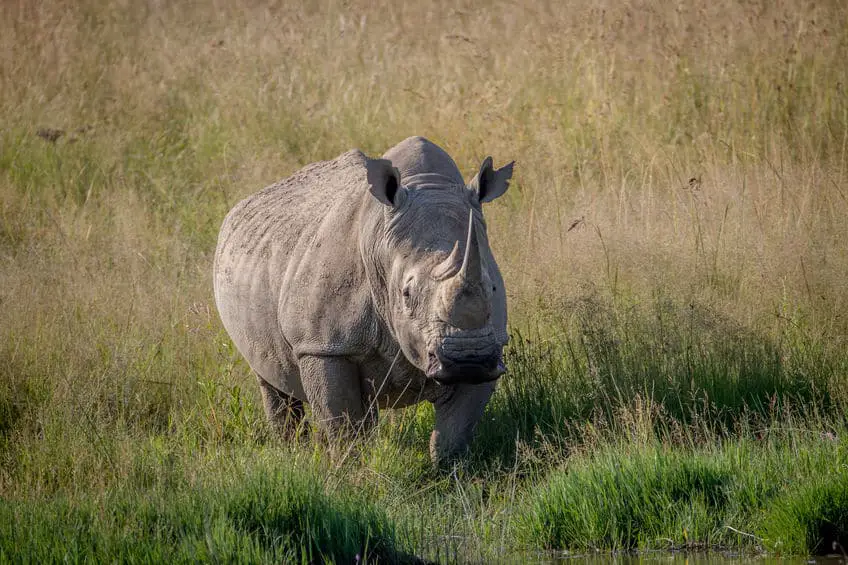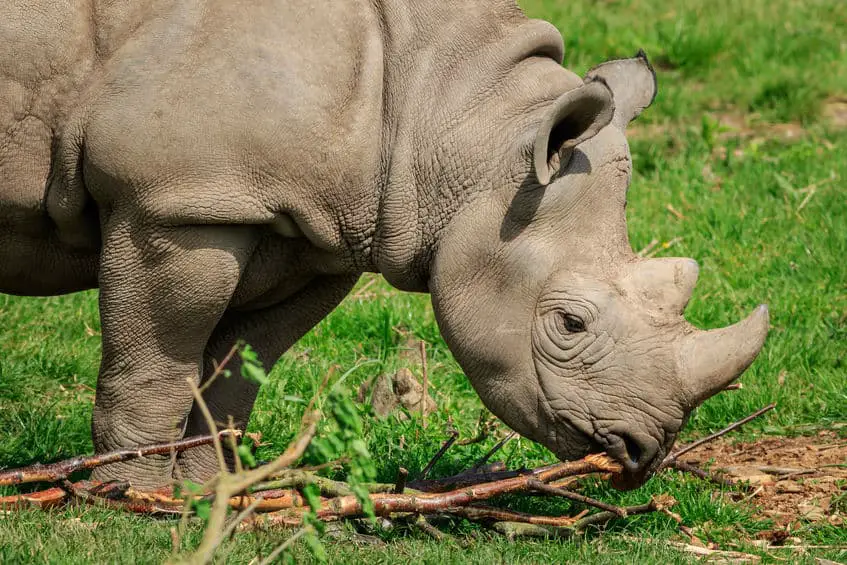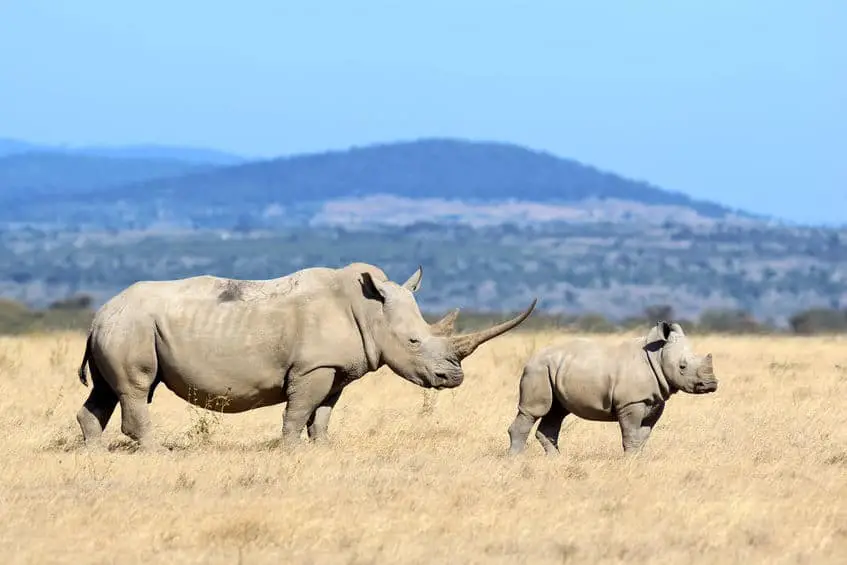
The rhinoceros is a proud member of the big five and is in many ways nature’s version of a tank. But there are actually several differences between the two types of African rhinoceros, the black and the white rhinoceros, that many people don’t know about.
What is the difference between black and white rhinoceros? The most distinct difference between black rhinoceros and white rhinoceros is the size. The white rhinoceros is almost twice as large as the black rhinoceros but there are also many other differences including diet, habitat, and rarity.
Despite what might seem logical, color is actually not one of the differences between the black and the white rhinoceroses. They are both gray and the shade of gray mostly depends on the mud they rolled around in last. Below I have covered 11 interesting differences between the two types of African rhinoceros.
1. White Rhinoceros is Almost Twice as Large as Black Rhinoceros
The most significant difference between the two types of African rhinoceros is the size. The white rhinoceros is almost twice as large as the black rhinoceros.
Already at birth, there is a big difference in the size between the two large African mammals. A newborn white rhinoceros weighs 40-65 kg. The black rhinoceros is significantly smaller with a birth weight of 30-45 kg.
When fully grown, the difference becomes much greater. A fully grown white rhinoceros male can weigh between 2000-3600 kg. which is as much as a female African elephant. The white rhinoceros females weigh a bit less with a typical weight between 1400-2000 kg.
While still being very large animals, fully grown black rhinoceroses weigh much less than their white cousins with a normal weight between 700-1400 kg.
White rhinoceroses are between 3.4-4 meters long and up to 1.80 meters tall measured at their shoulders. Black rhinoceroses are typically between 2.8-3.8 meters long and between 1.4-1.8 meters tall at the shoulders.
So as you can see, all in all, white rhinoceroses are significantly larger than black rhinoceroses.
For the next couple of headlines, I will dive into some other visual differences between the two types of African rhinoceros.
Since you have to be quite lucky to see the large mammal up close and usually will see them from a distance, I recommend getting some good binoculars to really be able to distinguish between the two types of African rhinoceros since they can look very similar from a distance. I have written a guide to help you select the right pair of binoculars for you including how to make them fit perfectly to your eyes and everything else you need to know. A pair of binoculars will make your safari experience much more fun and enjoyable.
2. The Shape of the Head and Face
Due to the large difference in size between the two types of African rhino, there is naturally also a difference in the size of their heads. But in addition to the natural difference in the size, there is actually also a very noticeable difference in the shape of the head in the two types of African rhinoceros.
The white rhino has a much longer head with a larger distance between the mouth and the ears where the black rhino has a shorter and more compact head. On top of that, the white rhinoceros has a much less defined forehead than the black rhinoceros.

3. Flat and Wide or Pointy and Hooked Upper Lip
One of the easiest and most safe ways to tell the difference between a black and a white rhinoceros is by taking a look at their upper lip.
The white rhinoceros has a 20-30 cm wide mouth which is extremely useful and efficient for picking and eating its favorite food, grass.
The black rhinoceros on the other hand has a very different and easily recognizable upper lip. It is more pointy and almost shaped like a short beak. The reason for this is that the black rhinos primary diet includes small twigs, branches, and berries. The hooked, beak-shaped mouth of the black rhinoceros is also very flexible and can work almost like a finger which is perfect for picking berries, breaking twigs, etc.
The primary reason why the two types of rhinoceros have such different upper lips is that they serve very different purposes since the two types of rhinos have very different diets. I will get into this in a bit. But first, a few more visual differences.
4. Large and Pointy or Small and Round Ears
Another notable difference between the two types of rhinoceros is the ears.
The black rhino has smaller and rounder ears than the white rhino. The white rhino has larger and more pointy ears. The reason why the white rhino has larger ears is that its head is typically closer to the ground due to its primary diet being grass and therefore needs to be better able to hear what’s going on around it.
So it is simply a matter of evolution that the white rhinoceros’ ears have developed the way they have. It is a tool for knowing what is going on in an area around the rhino and a means of basic survivability.

5. Different Horns
One of the most characteristic things about the African rhinoceros is of course the horns. Rhinos use their horns for several different purposes including combat and self-defense but also less hostile purposes such as digging for water and breaking branches.
The horns are also an indicator of a strong mate, so having a larger horn is usually beneficial for the rhino as it is more desirable for potential mates.
Both the black rhinoceros and the white rhinoceros have two horns. The white rhinoceros’ front horn is usually significantly larger and longer than the horn closest to its forehead. For the black rhinoceros, on the other hand, the two horns are closer to being the same length than those of the white rhino although the front horn is still the largest of the two.
Take a look at the images of both types of rhinoceros above. The difference is actually quite visible.
6. Different Habitat
African rhinoceroses are found in sub-Saharan Africa. Their habitat ranges from tropical and subtropical grasslands to savannas, shrublands, tropical moist forests, and deserts.
Both the white rhinoceros and the black rhinoceros are primarily found in South Africa, Namibia, Kenya, and Zimbabwe.
The natural habitat of the two types of African rhinoceros differs a bit between the two species which is primarily a result of their different diets (which I will get into below).
The white rhinoceros is found almost exclusively in open savannas and the ideal habitat for the black rhinoceros seems to consist of thick scrub and bushland, often with some woodland but they can also be found in savanna and even in deserts as long as they have a source of water.
There are actually two subspecies of white rhinoceros. A northern and a southern subspecies. Unfortunately, the last male of the northern subspecies died in 2018 and there are now only two females left. So to see white rhinoceros in the wild, you should go to the southern or eastern parts of Africa where they are found in South Africa, Namibia, Zimbabwe, and Kenya.
The black rhinoceros used to be widely distributed all over sub-Saharan Africa except in rainforests and the driest deserts. Now, they are almost exclusively found in protected areas such as national parks. The largest and most important black rhino populations are found in South Africa, Namibia, Kenya, and Zimbabwe.

7. Different Diet
Another quite significant difference between the two types of African rhinoceros is one I have already briefly touched upon and that is their diet.
The white rhinoceros’ diet consists almost exclusively of grass which it can find in the large open savannas of South Africa, Namibia, Kenya, and Zimbabwe. This is of course one of the primary reasons why the white rhinoceros are almost always spotted either in open savannas or very close to them since this is their ideal natural habitat.
The black rhinoceros on the other hand has a much broader menu than its white cousin. The black rhino can eat up to 100-200 different types of plants. It has an extremely strong stomach and can actually eat some poisonous species of plants which almost all other herbivores stay away from.
Thorns are not an issue for the black rhinoceros either and thorny plants such as acacia can actually make up a significant portion of their diet. In the desert, the black rhinoceros can survive by eating succulents as they contain a lot of water so they only need to drink water about once every fifth day.
8. The Dung
Since we have just talked about what the two types of African rhinoceros eat, a natural thing would be to talk about what happens next after they eat. Like all other species that eat, rhinos defecate.
Let’s talk about dung. Don’t worry, it won’t even be that smelly since rhino dung is made up mostly of digested grass.
You can actually tell if a black or a white rhinoceros has been around without even seeing the animal. All you need is a pile of dung. And by pile, I literally mean a big pile.
Rhinos tend to defecate in the same spot and create what is called a dung midden. Essentially a big pile of rhino poop.
There are several reasons for this, for instance, that those middens actually provide other rhinos with loads of information including age, sex, health, and reproductive status of the rhinos that created the midden.
Another reason for these communal rhino toilets is to mark their territory. Rhinos tend to place these middens at the border of their territory to inform bypassing rhinos that this territory is occupied.
As a result of the different diet the white rhinoceros and the black rhinoceros has, their dung also looks very different.
Dung from a white rhinoceros is made up almost purely from grass and is actually not digested that well so you can see the leaves of grass in there. It almost looks like freshly cut grass from a lawnmower.
Since the black rhinoceros has a different and more diverse diet than the white rhinoceros, their dung also looks different. It will contain small broken twigs and branches.
So to determine whether you have found a dung midden from a black or a white rhinoceros, have a closer look and see what it contains.

9. Long or Slightly Longer Gestation Period
Both the black rhinoceros and the white rhinoceros have significantly longer gestation periods than many other mammals including humans.
The white rhinoceros has a gestation period of around 16 months which is slightly (but not much) different than the gestation period of the black rhinoceros which is around 14.5-15 months.
So all in all, a white rhinoceros female is pregnant for slightly longer than a black rhinoceros female.
10. Different Social Preferences
While it is not uncommon to see a white rhinoceros by itself, they mostly stay in small groups with a couple of other white rhinos. The reason for this is simply to increase their overall safety by utilizing a “safety in numbers” tactic.
Fully grown white rhinoceroses generally do not have any predators in the wild other than humans but the younger individuals can sometimes become prey for both crocodiles and some of the big African cats.
The white rhinoceros mother stays with its calf for the first couple of years after giving birth but when the mother then gives birth to another calf (which usually happens after 2-3 years), the first calf is abandoned. The abandoned calf then seeks company, either by finding other young rhinos or by finding another female with no calf of its own.
The black rhinoceroses are generally less social than the white rhinoceroses and both male and female black rhinoceroses usually live on their own.
Sometimes, however, female black rhinoceroses can form a temporary group or even adopt abandoned calves similar to how the white rhinoceros do it.

11. Black Rhino is Rarer
At the beginning of the 20th century, there were about half a million rhinos worldwide (including both African and Asian rhinos). Today, only around 27000 rhinos are left in the wild so unfortunately, they are becoming a very rare sight.
The rapid and worrying decline in the number of rhinos is largely caused by loss of habitat but is also a result of poaching.
The most intense hunt for rhinos took place in the 1960s when the international trade with rhinoceros horns was thriving but African rhinoceroses were already systematically hunted and killed in the 1800s since humans wanted to use their habitat for agriculture and big game hunting.
In 2010, there were an estimated 20.000 white rhinoceroses left in Africa but since then, the number of poachers has unfortunately increased and the current number of white rhinos in the wild is unknown.
Black rhinoceroses are critically endangered. A study from 2010 estimated that there were roughly 5000 individuals left in the wild. Today, most black rhinos are found in protected areas such as national parks and reserves with an exception of a population living in Damaraland in north-western Namibia.
So all in all, there are unfortunately not a lot of wild rhinoceroses left in Africa but there is a lot of effort being done to preserve the species. The white rhinoceros is the most common of the two species and the black rhinoceros is significantly rarer.

